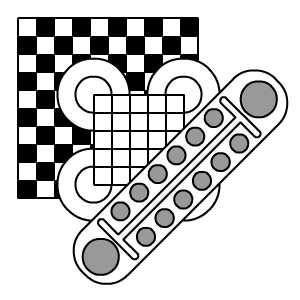| |

Board Game Studies Colloquium VIII
Abstracts
Andrew Perkis
HALMA: THE QUEST FOR VARIANTS WITH COMPLETE RULES
Many board games do not have complete rule sets. Aspects of play which can
be disputed add scope for a game to evolve on a democratic basis, so efforts
to eliminate them could often be sterile and pointless.
It is, however, a different matter if a game is to be played in organised
competition. As Alex de Voogt pointed out, "most games ... change when they
are played in championships ... special impasses in the game need to be
determined and solved".
In this paper I look at the game of Halma. My contention is, that IN THIS
PARTICULAR GAME, the fact that the flaws in its rule set have not been been
tackled in a thorough manner has not only prevented its play in organised
competitions but also stultified its refinement into more satisfactory
formats, which would provide a richer playing experience. An offshoot of
such evolution could have been- and still could be- a desire to play
variants of the game in a more organised manner compatible with championship
competitions.
Concern for fine print rules for Halma has been given impetus by the
interest value of "super jumps"- a term arising from the game Wayne
Schmittberger named Super Chinese Checkers. "Super Halma" was first
described in1963 as "Halma mit Weitsprung" and has been played in certain
circles since, though without becoming widespread. Super jumps are utilized
in the versions of Halma I propose because they make play more exciting-
and, in one case at least, enable a more interesting game format because of
their impact on the problem of blocking.
Blocking, together with the linked issue of proportion of occupied squares
to playing board area, is one of the major problem issues in Halma. Another
is SPOILING- by players leaving pieces in their home camps. In my
introduction I describe these problematic aspects of the game which operate
beyond the scope of current rules. I then present my understanding of how
not dealing with these issues halted the game in mid evolution- so that the
version that endured can be demonstrated not to be the best. There follows
an hypothesis as to why this state of affairs persisted- with standard Halma
even coming to be regarded as the classic game of its type. The introduction
ends with a glance at some of the anti spoiling measures which have been
proposed or used, none of which are totally satisfactory.
Finally, in the main part of the paper, I look more closely at the technical
issues, and, having dealt with the blocking/ density issue, put foreward
three effective approaches to deal with the problem of spoiling, in each
case giving an example of a version of the game to illustrate these. As
these examples all involve super jumps, I then give an appendix showing
applications to standard Halma versions (standard 16 x 16 and the two
nineteenth century "grasshopper" versions).
|

